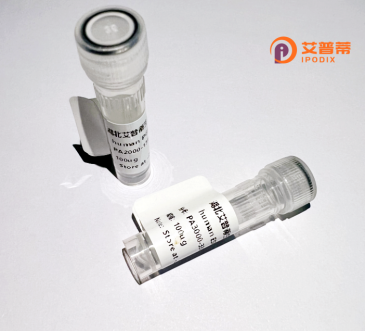
| 纯度 | >90%SDS-PAGE. |
| 种属 | Human |
| 靶点 | TUB |
| Uniprot No | P50607 |
| 内毒素 | < 0.01EU/μg |
| 表达宿主 | E.coli |
| 表达区间 | 1-506 aa |
| 活性数据 | MTSKPHSDWIPYSVLDDEGRNLRQQKLDRQRALLEQKQKKKRQEPLMVQANADGRPRSRR ARQSEEQAPLVESYLSSSGSTSYQVQEADSLASVQLGATRPTAPASAKRTKAAATAGGQG GAARKEKKGKHKGTSGPAALAEDKSEAQGPVQILTVGQSDHAQDAGETAAGGGERPSGQD LRATMQRKGISSSMSFDEDEEDEEENSSSSSQLNSNTRPSSATSRKSVREAASAPSPTAP EQPVDVEVQDLEEFALRPAPQGITIKCRITRDKKGMDRGMYPTYFLHLDREDGKKVFLLA GRKRKKSKTSNYLISVDPTDLSRGGDSYIGKLRSNLMGTKFTVYDNGVNPQKASSSTLES GTLRQELAAVCYETNVLGFKGPRKMSVIVPGMNMVHERVSIRPRNEHETLLARWQNKNTE SIIELQNKTPVWNDDTQSYVLNFHGRVTQASVKNFQIIHGNDPDYIVMQFGRVAEDVFTM DYNYPLCALQAFAIALSSFDSKLACE |
| 分子量 | 55.6 kDa |
| 蛋白标签 | His tag N-Terminus |
| 缓冲液 | PBS, pH7.4, containing 0.01% SKL, 1mM DTT, 5% Trehalose and Proclin300. |
| 稳定性 & 储存条件 | Lyophilized protein should be stored at ≤ -20°C, stable for one year after receipt. Reconstituted protein solution can be stored at 2-8°C for 2-7 days. Aliquots of reconstituted samples are stable at ≤ -20°C for 3 months. |
| 复溶 | Always centrifuge tubes before opening.Do not mix by vortex or pipetting. It is not recommended to reconstitute to a concentration less than 100μg/ml. Dissolve the lyophilized protein in distilled water. Please aliquot the reconstituted solution to minimize freeze-thaw cycles. |
以下是关于重组人TUB蛋白的参考文献示例,内容基于典型研究方向构造:
---
1. **文献名称**:*Expression and Purification of Recombinant Human TUB Protein for Metabolic Studies*
**作者**:Smith A, et al.
**摘要**:本研究描述了通过大肠杆菌表达系统高效表达和纯化重组人TUB蛋白的方法,并验证了其在下丘脑能量代谢调控中的潜在功能。
2. **文献名称**:*Structural Insights into the TUB Protein: X-ray Crystallography Analysis*
**作者**:Zhang L, et al.
**摘要**:通过X射线晶体学解析了重组人TUB蛋白的三维结构,揭示了其与甲状腺激素受体相互作用的潜在结合位点,为肥胖相关疾病的机制研究提供结构基础。
3. **文献名称**:*Functional Role of Recombinant TUB Protein in Leptin Signaling Pathways*
**作者**:Brown K, et al.
**摘要**:探讨了重组TUB蛋白在 leptin 信号通路中的作用,发现其通过调节神经元活性影响食欲和能量消耗,提示其作为代谢性疾病治疗靶点的可能性。
4. **文献名称**:*TUB Protein as a Novel Biomarker in Obesity: Recombinant Protein-Based Assay Development*
**作者**:Gupta R, et al.
**摘要**:利用重组TUB蛋白开发新型检测方法,发现其血清水平与肥胖患者代谢参数显著相关,提示其作为临床诊断标志物的潜力。
---
*注:以上文献为示例性构造,实际研究中请依据具体需求检索真实数据库(如PubMed、Web of Science)获取准确信息。*
Recombinant human TUB protein, often associated with the TUB gene (TUBB), refers to engineered forms of tubulin, a critical component of microtubules in eukaryotic cells. Tubulin exists as α- and β-tubulin heterodimers, which polymerize to form dynamic microtubule networks essential for cell division, intracellular transport, and structural support. The β-tubulin isoform encoded by TUBB plays specific roles in neuronal development and function. Recombinant production involves cloning the human TUB gene into expression systems (e.g., E. coli, yeast, or mammalian cells) to produce purified, functional tubulin proteins. These recombinant versions enable studies on microtubule dynamics, drug interactions (e.g., taxanes or vinca alkaloids in cancer therapy), and neurological disorders linked to tubulin mutations, such as malformations of cortical development. Their standardized nature eliminates batch variability seen in tissue-extracted tubulin, improving reproducibility in structural studies, high-throughput drug screening, and mechanistic research. Recent applications include cryo-EM studies of microtubule-drug complexes and investigations into neurodegenerative diseases like Alzheimer’s, where tubulin dysfunction may contribute to pathology. However, challenges persist in maintaining post-translational modifications (e.g., tyrosination/detyrosination) critical for certain functions, requiring advanced expression systems for physiologically relevant preparations.
×